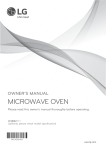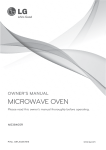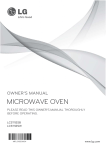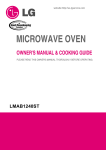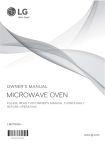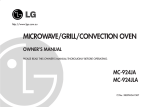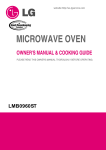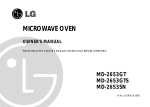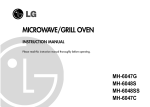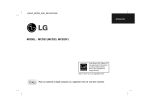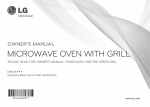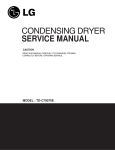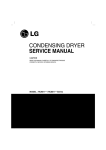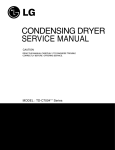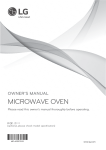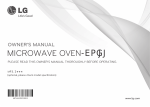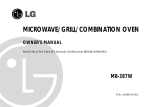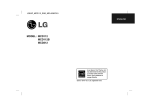Download LG MS1949G User's Manual
Transcript
http://au.lge.com(AUSTRALIA) http://nz.lge.com(NEW ZEALAND) MICROWAVE OVEN OWNER'S MANUAL & COOKING GUIDE MODEL : MS1949G PLEASE READ THIS OWNER’S MANUAL THOROUGHLY BEFORE OPERATING. PRECAUTIONS Precautions to avoid possible exposure to excessive microwave energy. You cannot operate your oven with the door open due to the safety interlocks built into the door mechanism. These safety interlocks automatically switch off any cooking activity when the door is opened; which in the case of a microwave oven could result in harmful exposure to microwave energy. It is important not to tamper with the safety interlocks. Do not place any object between the oven front face and the door or allow food or cleaner residue to accumulate on sealing surfaces. Do not operate your oven if it is damaged. It is particularly important that the oven door closes properly and that there is no damage to the: (1) door(bent), (2) hinges and latches (broken or loosened), (3) door seals and sealing surfaces. Your oven should not be adjusted or repaired by anyone except qualified service personnel. Warning Please ensure cooking times are correctly set as over cooking may result in the FOOD catching fire and subsequent damage to your oven. When heating liquids, e.g. soups, sauces and beverages in your microwave oven, overheating the liquid beyond boiling point can occur without evidence of bubbling. This could result in a sudden boil over of the hot liquid. To prevent this possibility the following steps should be taken: 1. Avoid using straight sided containers with narrow necks. 2. Do not overheat. 3. Stir the liquid before placing the container in the oven and again halfway through the heating time. 4. After heating, allow to stand in the oven for a short time, stir or shake them again carefully and check the temperature of them before consumption to avoid burns (especially, contents of feeding bottles and baby food jars). Warning Always allow food to stand after being cooked by microwaves and check the temperature of them before consumption. Especially contents of feeding bottles and baby food jars. How the Microwave Oven Works Microwaves are a form of energy similar to radio and television waves and ordinary daylight. Normally, microwaves spread outwards as they travel through the atmosphere and disappear without effect. Microwave ovens, however, have a magnetron which is designed to make use of the energy in microwaves. Electricity, supplied to the magnetron tube, is used to created microwave energy. These microwaves enter the cooking area through openings inside the oven. A turntable or tray is located at the bottom of the oven. Microwaves cannot pass through metal walls of the oven, but they can penetrate such materials as glass, porcelain and paper, the materials out of which microwave-safe cooking dishes are constructed. Microwaves do not heat cookware, though cooking vessels will eventually get hot from the heat generated by the food. A very safe appliance Your microwave oven is one of the safest of all home appliances. When the door is opened, the oven automatically stops producing microwaves. Microwave energy is converted completely to heat when it enters food, leaving no “left over” energy to harm you when you eat your food. 2 CONTENTS PRECAUTIONS 2 CONTENTS 3 UNPACKING & INSTALLING 4-5 FEATURE DIAGRAM 6 CONTROL PANEL 6 OPERATING INSTRUCTIONS 7 TIMED COOKING 7 MICROWAVE POWER LEVELS 7 CHILD LOCK 8 ADD MINUTE 8 QUICK START 8 QUICK DEFROST 9 QUICK DEFROST MENU INSTRUCTIONS 9 COOKING TIMER 10 ONE TOUCH AUTO MENU 10 ONE TOUCH AUTO MENU CHART 10 AUTO WEIGHT DEFROST 11 AUTO WEIGHT DEFROST SEQUENCE LIST 11 GROUND MEAT 12 GROUND MEAT COOKING CHART 12 POULTRY 12 POULTRY COOKING CHART 12 STEAKS/CHOPS 13 STEAKS/CHOPS COOKING CHART 13 HEATING OR REHEATING GUIDE 14 FRESH VEGETABLE GUIDE 15 MICROWAVE-SAFE UTENSILS 16 FOOD CHARACTERISTICS & MICROWAVE COOKING 17-18 SAFETY PRECAUTIONS 19-20 QUESTION & ANSWERS 21 PLUG WIRING INFORMATION/TECHNICAL SPECIFICATIONS 22 MANUFACTURER’S WARRANTY 23 3 UNPACKING & INSTALLING By following the basic steps on these two pages you will be able to quickly check that your oven is operating correctly. Please pay particular attention to the guidance on where to install your oven. When unpacking your oven make sure you remove all accessories and packing. Check to make sure that your oven has not been damaged during delivery. Unpack your oven and place it on a flat level surface. GLASS TRAY ROTATING RING Place your oven on a flat, level surface but make sure there is at least 10 cm of space on the top, rear and sides so there is air flow for ventilation. Exhaust outlets are located in the back and side of your oven. Blocking the outlets can damage your oven. THIS OVEN IS DESIGNED FOR AN INDIVIDUAUL BUILT IN APPLICATION. IT SHOULD NOT BE PART OF A WALL OVEN ENCLOSURE WITHOUT SEPERATION. THIS OVEN SHOULD NOT BE USED FOR COMMERCIAL CATERING PURPOSES 4 UNPACKING & INSTALLING Plug your oven into a standard household socket. Make sure your oven is the only appliance connected to the socket. If your oven does not operate properly, unplug it from the electrical socket and then plug it back in. Open your oven door by pressing the DOOR OPEN button. Place the ROTATING RING inside the oven and place the GLASS TRAY on top. Fill a microwave safe container with 300 ml (1/2 pint) of water. Place on the GLASS TRAY and close the oven door. If you have any doubts about what type of container to use please refer to page 16. automatically. Enter the time by touching [3] and [0]. And touch START. 30 SECONDS The DISPLAY will count down from 30 seconds. When it reaches 0 it will sound three BEEPS. Open the oven door and test the temperature of the water. If your oven is operating the water should be HOT. Be careful when removing the container it may be hot. YOUR OVEN IS NOW INSTALLED 5 FEATURE DIAGRAM Window Door Screen Remove your Microwave Oven and all material from the shipping carton. Your oven will be packed with the following materials: Oven Front Plate Door Seal Display Window Glass Turntable .........................1 each Control Panel Owner's Manual ........................1 each Rotating Ring.............................1 each Door Open Button Safety Door Lock System Glass Turntable This microwave oven is designed for household use only. It is not recommended for commercial purposes. Rotating Ring CONTROL PANEL NOTE: A beep sounds when a pad on the control panel is touched to indicate setting has been entered. 6 OPERATING INSTRUCTIONS TIMED COOKING 2 STAGE TIMED COOKING This function allows you to cook food for a desired time. And in order to give you the best results, there are 10 power level settings in addition to HI-POWER because many food need slower cooking (at less than HI-POWER). For Two Stage cooking, repeat timed cooking steps 2 through 5 on the previous page before touching the START pad for additional Time and Power program you want to add. Auto Weight Defrost can be programmed before the first stage to defrost first and then cook. Example:To cook food on 80% Power(Power8) for 5 minutes 30 seconds MICROWAVE POWER LEVELS Your microwave oven is equipped with ten power levels to give you maximum flexibility and control over cooking. The table below will give you some idea of which foods are prepared at each of the various power levels. *The table below shows the power level settings for your oven. 1. Touch STOP/CLEAR. 2. Touch TIME. MICROWAVE POWER LEVEL TABLE 3. Enter 5 minutes 30 seconds by touching [5], [3],and [0]. Power Level 4. Touch POWER. P-HI appears in the display. This is to tell you that the oven is set on HI unless a different power setting is chosen. 5. Touch 8. To select power level 80%. Display shows P-80. Use *Boiling water. *Making candy. 10 *Cooking poultry pieces, fish, & vegetables. (High) *Cooking tender cuts of meat. *Whole poultry. 6. Touch START. When cooking is complete, four short tones will sound. The word End shows in the display window. Then the oven shuts itself off. NOTE: If you do not select the power level, the oven will operate at power HIGH. To set HI-POWER cooking, skip steps 4 & 5 above. 7 9 *Reheating rice, pasta, & vegetables. 8 *Reheating prepared foods quickly. *Reheating sandwiches. 7 *Cooking egg, milk and cheese dishes. *Cooking cakes, breads. *Melting chocolate. 6 *Cooking veal. *Cooking whole fish. *Cooking puddings and custard. 5 *Cooking ham, whole poultry, lamb. *Cooking rib roast, sirloin tip. 4 *Thawing meat, poultry and seafood. 3 *Cooking less tender cuts of meat. *Cooking pork chops, roast. 2 *Taking chill out of fruit. *Softening butter. 1 *Keeping casseroles and main dishes warm. *Softening butter and cream cheese. 0 * Standing time. * Independent. OPERATING INSTRUCTIONS (CONT’D) CHILD LOCK ADD MINUTE This is a unique safety feature that prevents unwanted oven operation such as used by children. Once the CHILD LOCK is set, no cooking can take place. A time-saving pad, this simplified control lets you quickly set and start microwave cooking without the need to touch START. Example : To set ADD MINUTE cooking 2 minutes. To set the child lock 1. Touch STOP/CLEAR. 1. Touch STOP/CLEAR. or 2. Touch ADD MINUTE 2 times.The oven begins cooking and display shows time counting down. 2. Touch and hold 0,or STOP/CLEAR until L appears in the display and two beeps are heard. If the time of day was already set, the time of day will return to the display window. After you touch another cooking pad. NOTE: If you touch ADD MINUTE, it will add 1 minute up to 99 minutes 59 seconds. QUICK START If the CHILD LOCK was already set and you touched another cooking pad, the word LOCKED shows in the display. Then you can cancel the CHILD LOCK according to below procedure. The QUICK START feature allows you to set 30 seconds intervals of HIGH power cooking with a touch of the START/Q-START. Example: Set 2 minutes of cooking on high power. To cancel the child lock or Touch and hold 0 ,or STOP/CLEAR until L disappears in the display. 1. 1. Touch STOP/CLEAR. 2. 2. Touch START/Q-START Four times on high power You oven will start before you have finished the fouth press. During QUICK START cooking,you can extend the cooking time up to 10 minutes by repeatedly pressing the START/Q-START key. After the CHILD LOCK is turned off, the time of day will return to the display window. The oven will operate normally. 8 OPERATING INSTRUCTIONS (CONT’D) QUICK DEFROST Example: To defrost 0.5 kg meat. Three Quick Defrost sequences are preset in the oven. The Quick Defrost feature provides you with the express defrosting method for 500g frozen foods. The oven automatically sets the defrosting time for each food. 1. Touch STOP/CLEAR. NOTE: The oven will beep during the DEFROST CYCLE. At this time open the door and turn over, separate, or rearrange the food. Quick Defrost provides just enough defrosting that the foods can be used in recipes or for cooking. There will be some ice crystals remaining. 2. Touch QUICK DEFROST. QUICK DEFROST MENU INSTRUCTIONS Code 1 Menu Minced Meat Weight Limit Initial Temperature 0.5 kg Frozen Instructions Use this function to defrost mince meat. Remove the meat completely from it’s wrapping. Place the mince onto a microwave- safe rack over a plate or shallow dish. During the program the oven will beep . At this point remove the mince from the microwave oven, remove any defrosted mince to a plate, cover and set aside. Turn the frozen mince over and return to the microwave oven. Press start to continue. At the end of the program remove the mince from the microwave oven, cover with foil and allow to stand 5- 20 minutes or until completely thawed. 9 Standing Time (minutes) 5 - 20 OPERATING INSTRUCTIONS (CONT’D) COOKING TIMER ONE TOUCH AUTO MENU You can use the Timer of your oven for purposes other than food cooking. Example: To count 3 minutes for an egg or telephone call One Touch Auto Menu made easy! Your oven's menu has been preprogrammed to cook food automatically. Tell the oven what you want. Then let your microwave oven cook your selections. Example: To cook popcorn, simply follow the step below Touch STOP/CLEAR. COOKING Touch STOP/CLEAR. *Place popcorn in the oven and close the door. Touch COOKING TIMER. Touch POPCORN. The oven begins the cooking you selected without the need to touch START. Be sure to close the door before selecting categories. Touch numbers to set. Touch START. ONE TOUCH AUTO MENU CHART Key Touch Serving size Directions Follow package instructions. Use popcorn package which is made especially for microwave cooking. Do not try to pop unpopped kernels. Heat only 1 package at a time. Do not leave the microwave oven unattended while popping popcorn. 1 Time 2 Times 3 Times 100 g. 85 g. 50 g. 1 Time 2 Times 3 Times 4 Times 1 ea 2 ea 3 ea 4 ea BEVERAGE 1 Time 2 Times 1 cup 2 cups Use mug or microwave-safe cup. Stir after reheating. FRESH VEGETABLE 1 Time 2 Times 3 Times 4 Times 1 cup 2 cups 3 cups 4 cups Prepare vegetable(wash and cut into 12.7mm pieces). Cover with plastic wrap and vent. FROZEN VEGETABLE 1 Time 2 Times 3 Times 4 Times 1 cup 2 cups 3 cups 4 cups Arrange food on turntable tray. Cover with plastic wrap and vent. FROZEN ENTREE 1 Time 284 g. Follow the package instructions. POPCORN POTATO Place in center of the oven on paper towel. Pierce potato several times with fork. After cooking, let stand for 5 minutes. 10 OPERATING INSTRUCTIONS (CONT’D) AUTO WEIGHT DEFROST NOTE: When you touch the START pad, the display changes to defrost time count down. The oven will beep during the DEFROST cycle. At this time, open the door and turn, separate, or rearrange the food. Remove any portions that have thawed. Return frozen portions to the oven and touch START to resume the defrost cycle. Three defrost sequences are preset in the oven. The defrost feature provides you with the best defrosting method for frozen foods. The cooking guide will show you which defrost sequence is recommended for the food you are defrosting. With the Auto Weight Defrost feature, the oven automatically sets the defrosting time and power levels for you. The oven automatically determines required defrosting times for each food item according to the weight you enter. For added convenience, the Auto Weight Defrost Feature contains a built-in beep mechanism that lets you check, turn over, separate or rearrange as recommended in the Auto Defrosting AUTO WEIGHT DEFROST GUIDE. Three different defrosting levels are provided. dEF 1 : GROUND MEAT dEF 2 : POULTRY dEF 3 : STEAKS/CHOPS *You can select the category by touching the key once (GROUND MEAT), twice (POULTRY), or three times(STEAKS/CHOPS). *Available weight is 0.1~4.0 kg. However, when you want to defrost and cook consecutively, you should enter less than 4.0 kg. If you attempt to defrost and cook 4.1 kg consecutively, Err will show in the display window. Example: To defrost 1.2 kg of ground beef, select Meat menu, enter the weight, and press START. OPERATING TIPS • For best results, remove fish, shellfish, meat, and poultry from its original closed paper or plastic package (wrapper). Otherwise, the wrap will hold steam and juice close to the foods, which can cause the outer surface of the foods to cook. • For best results, shape your ground meat into the form of a doughnut before freezing. When defrosting, scrape off thawed meat when the beep sounds and continue defrosting. • Place foods in a shallow container or on a microwave roasting rack to catch drippings. • Food should still be somewhat icy in the center when removed from the oven. AUTO WEIGHT DEFROST SEQUENCE LIST Sequence 1 GROUND MEAT Touch STOP/CLEAR. Touch AUTO DEFROST. Food Ground beef, Round steak, Cubes for stew, Tenderloin steak, Pot roast, Rib roast, Rump roast, Chuck roast, Hamburger patty. LAMB Chop(25.4mm thick), Rolled roast PORK Chop(12.7mm thick), Hot dogs, Spareribs, Country-style ribs. Rolled roast, Sausage. VEAL Cutlets(0.5 kg,12.7mm thick) POULTRY Whole(under 4 kg), Cut up Breasts 2 (boneless) POULTRY CORNISH HENS Whole TURKEY ............................. Breast(under 4 kg) ............................. dEF 1 appears in the display. Enter the weight by touching [1] and [2]. 1.2 appears in the display. ............................. STEAKS ............................. 3 Touch START. Defrosting starts. ............................... 11 STEAKS/ CHOPS Round steaks,Tenderloin steak. CHOPS Lamb chops (25.4mm thick), Pork chops (12.7mm thick). OPERATING INSTRUCTIONS (CONT’D) WARNING : Do not use aluminum foil during cooking cycle. GROUND MEAT POULTRY 1. No special techniques are required. The roast should be prepared and seasoned (if desired) as for any other conventional method. Meat should be thoroughly defrosted before cooking. 2. Place the meat on a microwave roasting rack or ovenproof plate and place on the turntable. 3. Cook according to the cooking chart (below), using the longer time for large meats and the shorter time for smaller meats. For thicker chops, use the longer time. 4. Turn the meat once halfway through the cooking time. 5. STAND for 5-10 minutes wrapped in foil after cooking. The standing time is very important as it completes the cooking process. 6. Ensure meat, especially pork, is thoroughly cooked before eating. 1. No special techniques are required. The poultry should be prepared as for any other conventional method. Season if desired. 2. Poultry should be thoroughly defrosted, ensuring giblets and any metal clamps are removed. 3. Prick the skin and brush lightly with vegetable oil unless self-basting. 4. All poultry should be placed on a microwave roasting rack or a microwave-proof plate and placed on the turntable. 5. Cook according to the instructions in the cooking chart (below), turning the bird over halfway through the cooking time. Poultry, because of its shape, has a tendency to cook unevenly, especially in very bony parts. Turning the bird during roasting helps to cook these areas evenly. 6. STAND for 5-10 minutes wrapped in foil after cooking before carving. The standing time is very important, as it completes the cooking process. 7. Ensure poultry is thoroughly cooked before eating. Whole poultry is completely cooked when the juices run clear from the inside thigh when it is pierced with a sharp knife. Poultry portions should be pierced with a sharp knife through the thickest part to ensure that the juices are clear and the flesh is firm. GROUND MEAT COOKING CHART Cut Microwave Cooking time power per pound BEEF Standing/Rolled Rib -Rare 8 -Medium 8 -Well-done 8 Ground Beef HIGH (to brown for casserole) Hamburgers, Fresh or defrosted (113g each) -2 patties HIGH(100%) -4 patties HIGH(100%) PORK Loin, Leg Bacon -4 slices -6 slices 9~11 minutes 10~12 minutes 12~14 minutes 7~9 minutes POULTRY COOKING CHART Poultry 3~5 minutes 4~6 minutes 8 13~16 minutes HIGH HIGH 3~4 minutes 4~6 minutes CHICKEN Whole Breast(boned) Portions TURKEY Whole Microwave power Cooking time per pound 8 8 8 12~14 minutes 10~12 minutes 11~13 minutes 8 13~15 minutes NOTE: *The above times should be regarded only as a guide. Allow for difference in individual tastes and preferences. The times may vary due to the shape, cut, and composition of the food. *If whole birds are stuffed, the weight of the stuffed bird should be used when calculating the cooking time. NOTE: The above times should be regarded only as a guide. Allow for difference in individual tastes and preferences. The times may vary due to the shape, cut, and composition of the meat. 12 OPERATING INSTRUCTIONS (CONT’D) STEAKS/CHOPS 1. Arrange fish in a large shallow non-metallic dish or casserole. 2. Cover with pierced microwave plastic film or casserole lid. 3. Place the dish on the turntable. 4. Cook according to the instructions in the cooking chart (below). Flakes of butter can be added to the fish if desired. 5. Let STAND as directed in the cooking chart before serving. 6. After standing time, check to see that the fish is thoroughly cooked. The fish should be opaque and flake easily. STEAKS/CHOPS COOKING CHART Fish Microwave power Cooking Time per pound Method Fish Fillets HIGH 5~7 minutes Whole Mackerel, Cleaned and Prepared HIGH 5~7 minutes 3~4 minutes Whole Trout, Cleaned and Prepared HIGH 6~8 minutes 3~4 minutes Salmon Steaks HIGH 6~7 minutes 13 Add 15~30 ml (1~2 tbsp.) Standing Time Add 15~30 ml (1~2 tbsp.) 2~3 minutes 3~4 minutes OPERATING INSTRUCTIONS HEATING OR REHEATING GUIDE To heat or reheat successfully in the microwave, it is important to follow several guidelines. Measure the amount of food in order to determine the time needed to reheat. Arrange the food in a circular pattern for best results. Room temperature food will heat faster than refrigerated food. Canned foods should be taken out of the can and placed in a microwavable container. The food will be heated more evenly if covered with a microwavable lid or plastic wrap and vented. Remove cover carefully to prevent steam burns. Use the following chart as a guide for reheating cooked food. Items Cook time (at HIGH) Special Instructions Sliced meat 3 slices (0.5 cm thick) 1-21/2 minutes Place sliced meat on microwavable plate. Cover with plastic wrap and vent. *Note: Gravy or sauce helps to keep meat juicy. Chicken pieces 1 breast 1 leg and thigh 2-31/2 minutes 3-4 minutes Place chicken pieces on microwavable plate. Cover with plastic wrap and vent. Fish fillet (230 g) 1-21/2 minutes Place fish on microwavable plate. Cover with plastic wrap and vent. 4-7 minutes Place lasagna on microwavable plate. Cover with plastic wrap and vent. Lasagna 1 serving (300 g) Casserole 1 cup 4 cups Casserole – cream or cheese 1 cup 4 cups Sloppy Joe or Barbecued beef 1 sandwich (1/2 cup meat filling) without bun Mashed potatoes 1 cup 4 cups Baked beans 1 cup Ravioli or pasta in sauce 1 cup 4 cups Rice 1 cup 4 cups Sandwich roll or bun 1 roll Vegetables 1 cup 4 cups Soup 1 serving (230 g) 1-31/2 minutes 5-9 minutes COOK covered in microwavable casserole. Stir once halfway through cooking. 1-3 minutes 31/2-7 minutes COOK covered in microwavable casserole. Stir once halfway through cooking. 1 -3 minutes Reheat filling and bun separately. Cook filling covered in microwavable casserole. Stir once. Heat bun as directed in chart below. 11/2 -3 minutes 7-10 minutes COOK covered in microwavable casserole. Stir once halfway through cooking. 11/2-31/2 minutes COOK covered in microwavable casserole. Stir once halfway through cooking. 21/2-5 minutes 81/2-13 minutes COOK covered in microwavable casserole. Stir once halfway through cooking. 1-11/2 minutes 3-6 minutes COOK covered in microwavable casserole. Stir once halfway through cooking. Wrap in paper towel and place on glass mircrowavable rack 17-34 seconds 11/2-21/2 minutes 5-7 minutes 11/2-3 minutes COOK covered in microwavable casserole. Stir once halfway through cooking. COOK covered in microwavable casserole. Stir once halfway through cooking. 14 OPERATING INSTRUCTIONS FRESH VEGETABLE GUIDE Amount Cook time at HIGH Artichokes (230 g each) 2 medium 4 medium 41/2 ~9 11~14 Trim. Add 2 tsp water and 2 tsp juice. Cover. 2-3 minutes Asparagus, Fresh, Spears 450 g 21/2 ~7 Add 1 cup water. Cover. 2-3 minutes Beans, Green & Wax 450 g 8~13 Add 1/2 cup water in 11/2 qt. casserole. Stir halfway through cooking. 2-3 minutes Beets, Fresh 450 g 13~18 Add 1/2 cup water in 11/2 qt. covered casserole. Rearrange halfway through cooking. 2-3 minutes Broccoli, Fresh, Spears 450 g 6~9 Place broccoli in baking dish. Add 1/2 cup water. 2-3 minutes Cabbage, Fresh, Chopped 450 g 4~8 Add 1/2 cup water in 11/2 qt. covered casserole. Stir halfway through cooking. 2-3 minutes Carrots, Fresh, Sliced 2 cups 2~4 Add 1/4 cup water in 1 qt. covered casserole. Stir halfway through cooking. 2-3 minutes Cauliflower, Fresh, Whole 450 g 6~9 Trim. Add 1/4 cup water in 1 qt. covered casserole. Stir halfway through cooking. 2-3 minutes Flowerettes, Fresh 2 cups Slice. Add 1/2 cup water in 11/2 qt. covered casserole. 2-3 minutes Celery, Fresh, Sliced 4 cups 21/2~51/2 7~10 Corn, Fresh 2 ears 5~10 Mushrooms, Fresh, Sliced 230 g 21/2~41/2 Parsnips, Fresh, 450 g 5~9 4 cups 7~11 Add 1/2 cup water in 11/2 qt. covered casserole. Stir halfway through cooking. 2-3 minutes Sweet Potatoes Whole Baking (170~230 g each) 2 medium 4 medium 5~11 8~14 Pierce potatoes several times with fork. Place on 2 paper towels. Turn over halfway through cooking. 2-3 minutes 2-3 minutes White Potatoes, Whole Baking (170~230 g each) 2 potatoes 4 potatoes 6~10 12~16 Pierce potatoes several times with fork. Place on 2 paper towels. Turn over halfway through cooking. 2-3 minutes 2-3 minutes 450 g 5~9 Add 1/2 cup water in 2 qt. covered casserole. 2-3 minutes Squash, Acorn or Butternut, Fresh 1 medium 7~10 Cut squash in half. Remove seeds. Place in 8 x 8-inch baking dish. Cover. 2-3 minutes Zucchini, Fresh, Sliced 450 g 41/2~91/2 Add 1/2 cup water in 11/2 qt. covered casserole. Stir halfway through cooking. 2-3 minutes Zucchini, Fresh, Whole 450 g 7~11 Pierce. Place on 2 paper towels. Turn zucchini over and rearrange halfway through cooking. 2-3 minutes Vegetable Sliced Peas, Green, Fresh Spinach, Fresh, Leaf Instructions Standing Time Stir halfway through cooking. Husk. Add 2 tbsp water in 11/2 qt. baking dish. Cover. 2-3 minutes Place mushrooms in 11/2 qt. covered casserole. Stir halfway through cooking. 2-3 minutes Add 1/2 cup water in 11/2 qt. covered casserole. 2-3 minutes Stir halfway through cooking. 15 MICROWAVE-SAFE UTENSILS Never use metal or metal trimmed utensils in your microwave oven Microwaves cannot penetrate metal. They will bounce off any metal object in the oven and cause arcing, an alarming phenomenon that resembles lightning. Most heat resistant non metallic cooking utensils are safe for use in your microwave oven. However, some may contain materials that render them unsuitable as microwave cookware. If you have any doubts about a particular utensil, there’s a simple way to find out if it can be used in your microwave oven. Place the utensil in question next to a glass bowl filled with water in the microwave oven. Microwave at power HIGH for 1 minute. If the water heats up but the utensil remains cool to the touch, the utensil is microwave-safe. However, if the water does not change temperature but the utensil becomes warm, microwaves are being absorbed by the utensil and it is not safe for use in the microwave oven. You probably have many items on hand in your kitchen right now that can be used as cooking equipment in your microwave oven. Just read through the following checklist. Dinner plates Many kinds of dinner-ware are microwave-safe. If in doubt consult the manufacturer’s literature or perform the microwave test. Glassware Glassware that is heat-resistant is microwavesafe. This would include all brands of oven tempered glass cookware. However, do not use delicate glassware, such as tumblers or wine glasses, as these might shatter as the food warms. Plastic storage containers These can be used to hold foods that are to be quickly reheated. However, they should not be used to hold foods that will need considerable time in the oven as hot foods will eventually warp or melt plastic containers. Paper Paper plates and containers are convenient and safe to use in your microwave oven, provided that the cooking time is short and foods to be cooked are low in fat and moisture. Paper towels are also very useful for wrapping foods and for lining baking trays in which greasy foods such as bacon are cooked. In general, avoid colored paper products as the colour may run. Some recycled paper products may contain impurities which could cause arcing or fires when used in the microwave oven. Plastic cooking bags Provided they are made specially for cooking, cooking bags are microwave safe. However, be sure to make a slit in the bag so that steam can escape. Never use ordinary plastic bags for cooking in your microwave oven, as they will melt and rupture. Plastic microwave cookware A variety of shapes and sizes of microwave cookware are available. For the most part, you can probably use items you already have on hand rather than investing in new kitchen equipment. Pottery, stoneware and ceramic Containers made of these materials are usually fine for use in your microwave oven, but they should be tested to be sure. CAUTION Some items with high lead or iron content are not suitable for cooking utensils. 16 FOOD CHARACTERISTICS & MICROWAVE COOKING Keeping an eye on things The recipes in this book have been formulated with great care, but your success in preparing them depends on how much attention you pay to the food as it cooks. Always watch your food while it cooks. Your microwave oven is equipped with a light that turns on automatically when the oven is in operation so that you can see inside and check the progress of your food. Directions given in recipes to elevate, stir, and the like should be thought of as the minimum steps recommended. If the food seems to be cooking unevenly, simply make the necessary adjustments you think appropriate to correct the problem. Factors affecting microwave cooking times Many factors affect cooking times. The temperature of ingredients used in a recipe makes a big difference in cooking times. For example, a cake made with ice-cold butter, milk, and eggs will take considerably longer to bake than one made with ingredients that are at room temperature. All of the recipes in this book give a range of cooking times. In general, you will find that the food remains under-cooked at the lower end of the time range, and you may sometimes want to cook your food beyond the maximum time given, according to personal preference. The governing philosophy of this book is that it is best for a recipe to be conservative in giving cooking times. While overcooked food is ruined for good. Some of the recipes, particularly those for bread, cake, and custards, recommend that food be removed from the oven when they are slightly undercooked. This is not a mistake. When allowed to stand, usually covered, these foods will continue to cook outside of the oven as the heat trapped within the outer portions of the food gradually travels inward. If the food is left in the oven until it is cooked all the way through, the outer portions will become overcooked or even burnt. You will become increasingly skilful in estimating both cooking and standing times for various foods. Density of food Light, porous food such as cakes and bread cook more quickly than heavy, dense foods such as roasts and casseroles. You must take care when microwaving porous food that the outer edges do not become dry and brittle. Height of food The upper portion of tall food, particularly roasts, will cook more quickly than the lower portion. Therefore, it is wise to turn tall food during cooking, sometimes several times. Moisture content of food Since the heat generated from microwaves tends to evaporate moisture, relatively dry food such as roasts and some vegetables should either be sprinkled with water prior to cooking or covered to retain moisture. Bone and fat content of food Bones conduct heat and fat cooks more quickly than meat. Care must be taken when cooking bony or fatty cuts of meat that they do not cook unevenly and do not become overcooked. Quantity of food The number of microwaves in your oven remains constant regardless of how much food is being cooked. Therefore, the more food you place in the oven, the longer the cooking time. Remember to decrease cooking times by at least one third when halving a recipe. Shape of food Microwaves penetrate only about 2.5 cm into food, the interior portion of thick foods are cooked as the heat generated on the outside travels inward. Only the outer edge of food is cooked by microwave energy; the rest is cooked by conduction. The worst possible shape for a food that is to be microwaved is a thick square. The corners will burn long before the centre is even warm . Round thin foods and ring shaped foods cook successfully in the microwave. Covering A cover traps heat and steam which causes food to cook more quickly. Use a lid or microwave cling film with a corner folded back to prevent splitting. Browning Meats and poultry that are cooked fifteen minutes or longer will brown lightly in their own fat. Food that is cooked for a shorter period of time may be brushed with a browning sauce such as Worcestershire sauce, soy sauce or barbecue sauce to achieve an appetizing colour. Since relatively small amounts of browning sauce is added to food, the original flavour of the recipe is not altered. Covering with greaseproof paper Greaseproofing effectively prevents spattering and helps food retain some heat. But because it makes a looser cover than a lid or clingfilm, it allows the food to dry out slightly. Arranging and spacing Individual foods such as baked potatoes, small cakes and hors d’oeuvres will heat more evenly if placed in the oven an equal distance apart, preferably in a circular pattern. Never stack foods on top of one another. 17 FOOD CHARACTERISTICS & MICROWAVE COOKING Standing time Stirring Stirring is one of the most important of all microwaving techniques. In conventional cooking, food is stirred for the purpose of blending. Microwaved food, however, is stirred in order to spread and redistribute heat. Always stir from the outside towards the centre as the outside of the food heats first. Foods are often allowed to stand for 3 to 10 minutes after being removed from the microwave oven. Usually the foods are covered during standing time to retain heat unless they are supposed to be dry in texture (some cakes and biscuits, for example). Standing allows foods to finish cooking and also helps flavour blend and develop. Turning over Large, tall foods such as roasts and whole chickens should be turned so that the top and bottom will cook evenly. It is also a good idea to turn cut up chicken and chops. To Clean Your Oven 1 Keep the inside of the oven clean Food spatters or spilled liquids stick to oven walls and between seal and door surface. It is best to wipe up spillovers with a damp cloth right away. Crumbs and spillovers will absorb microwave energy and lengthen cooking times. Use a damp cloth to wipe out crumbs that fall between the door and the frame. It is important to keep this area clean to assure a tight seal. Remove greasy spatters with a soapy cloth then rinse and dry. Do not use harsh detergent or abrasive cleaners. The glass tray can be washed by hand or in the dishwasher. Placing thicker portions facing outwards Since microwaves are attracted to the outside portion of food, it makes sense to place thicker portions of meat, poultry and fish to the outer edge of the baking dish. This way, thicker portions will receive the most microwave energy and the food will cook evenly. Shielding Strips of aluminium foil (which block microwaves) can be placed over the corners or edges of square and rectangular food to prevent those portions from overcooking. Never use too much foil and make sure the foil is secured to the dish or it may cause ‘arcing’ in the oven. 2 Keep the outside of the oven clean Clean the outside of your oven with soap and water then with clean water and dry with a soft cloth or paper towel. To prevent damage to the operating parts inside the oven, the water should not be allowed to seep into the ventilation openings. To clean control panel, open the door to prevent oven from accidentally starting, and then wipe the control panel with a damp cloth, followed immediately by a dry cloth. Press STOP after cleaning. Elevating Thick or dense foods can be elevated so that microwaves can be absorbed by the underside and centre of the foods. Piercing Foods enclosed in a shell, skin or membrane are likely to burst in the oven unless they are pierced prior to cooking. Such foods include yolks and whites of eggs, clams and oysters and whole vegetables and fruits. 3 If steam accumulates inside or around the outside of the oven door, wipe the panels with a soft cloth. This may occur when the microwave oven is operated under high humidity conditions and in no way indicates a malfunction of the unit. Testing if cooked Food cooks so quickly in a microwave oven, it is necessary to test it frequently. Some foods are left in the microwave until completely cooked, but most foods, including meats and poultry, are removed from the oven while still slightly undercooked and allowed to finish cooking during standing time. The internal temperature of foods will rise between 3°C and 8°C during standing time. 4 The door and door seals should be kept clean. Use only warm, soapy water, rinse then dry thoroughly. DO NOT USE ABRASIVE MATERIALS, SUCH AS CLEANING POWDERS OR STEEL AND PLASTIC PADS. Metal parts will be easier to maintain if wiped frequently with a damp cloth. 18 SAFETY PRECAUTIONS WARNING Please ensure cooking times are correctly set as over cooking may result in FIRE and subsequent DAMAGE to the OVEN. 11 Be certain to place the oven so the front of the door is 8 cm or more behind the edge of the surface on which it is placed, to avoid accidental tipping of the appliance. 1 Do not attempt to tamper with, or make any adjustments or repairs to the door, control panel, safety interlock switches or any other part of the oven. Repairs should only be undertaken by a qualified service technician. 12 Before cooking, pierce the skin of potatoes, apples or any such fruit or vegetable. 2 Do not operate the oven when empty. It is best to leave a glass of water in the oven when not in use. The water will safety absorb all microwave energy, if the oven is accidentally started. 13 Do not cook eggs in their shell. Pressure will build up inside the egg which will burst. 3 Do not use the oven for the purpose of dehumidification. It can be the cause of serious damage of safety. (ex. Operating the microwave oven with the wet newspapers, clothes, toys, pet or portable electric devices, etc.) 14 Do not attempt deep fat frying in your oven. 15 Remove the plastic wrapping from food before cooking or defrosting. Note though that in some cases food should be covered with plastic film, for heating or cooking. 4 Do not cook food wrapped in paper towels, unless your cook book contains instructions, for the food you are cooking. 16 If the oven door is damaged, the oven must not be operated until it has been repaired by a qualified service technician. 5 Do not use newspaper in place of paper towels for cooking. 17 If smoke is observed, keep the oven door closed and switch off or disconnect the oven from the power supply. 6 Do not use wooden containers. They may heatup and char. Do not use ceramic containers which have metallic (e.g. gold or silver) inlays. Always remove metal twist ties. Metal objects in the oven may arc, which can cause serious damage. 18 When food is heated or cooked in disposable containers of plastic, paper or other combustible materials look at the oven frequently to check if the food container is deteriorating. 7 Do not operate the oven with a kitchen towel, a napkin or any other obstruction between the door and the front edges of the oven, which may cause microwave energy leakage. 19 The appliance is not intended for use by young children or infirm persons without supervision; Young Children should be supervised to ensure that they do not play with appliance. 8 Do not use recycled paper products since they may contain impurities which may cause sparks and/or fires when used in cooking. 20 Liquids or other foods must not be heated in sealed containers since they are liable to explode. 9 Do not rinse the turntable by placing it in water just after cooking. This may cause breakage or damage. 21 If the appliance is supplied from a cord extension set or an electrical portable outlet device,the cord extension set on electrical portable outlet device must be positioned so that it is not subject to splashing or ingress of moisture. 10 Small amounts of food require shorter cooking or heating time. If normal times are allowed they may overheat and burn. 19 SAFETY PRECAUTIONS WARNING Please ensure cooking times are correctly set as over cooking may result in FIRE and subsequent DAMAGE to the OVEN. 27 Only use the temperature probe recommended for this oven (for appliances having a facility to use a temperature-sensing probe). 22 It is hazardous for anyone other than a competent person to carry out any service or repair operation that involves the removal of a cover which gives protection against exposure to microwave energy. 28 The microwave oven shall not be placed in a cabinet unless it has been tested in a cabinet (The manufacturer shall state in the instructions whether the microwave oven is intended to be used freestanding, built-in or in a cabinet. The minimum dimension of the cabinet shall be given by the manufacturer.). 23 Only allow children to use the oven without supervision when adequate instructions have been given so that the child is able to use the oven in a safe way and understands the hazards of improper use. 24 The minimum height of free space necessary above the top surface of the oven. 29 This appliance is not intended for use by persons (including children) with reduced physical, sensory or mental capabilities, or lack of experience and knowledge, unless they have been given supervision or instruction concerning use of the appliance by a person responsible for their safety. 25 The oven should be cleaned regularly and any food deposits removed. 26 Failure to maintain the oven in a clean condition could lead to deterioration of the surface that could adversely affect the life of the appliance and possibly result in a hazardous situation. 20 QUESTION & ANSWERS Q What’s wrong when the oven light will not glow? A There may be several reasons why the oven light will not glow. Light bulb has blown. Door is not closed. 1 Popcorn-popping utensils designed specifically for microwave cooking. 2 Prepackaged commercial microwave popcorn that contains specific times and power outputs needed for an acceptable final product. FOLLOW EXACT DIRECTIONS GIVEN BY EACH MANUFACTURER FOR THEIR POPCORN PRODUCT. DO NOT LEAVE THE OVEN UNATTENDED WHILE THE CORN IS BEING POPPED. IF CORN FAILS TO POP AFTER THE SUGGESTED TIMES, DISCONTINUE COOKING. OVERCOOKING COULD RESULT IN THE CORN CATCHING FIRE. Q Does microwave energy pass through the viewing screen in the door? A No. The holes, or ports, are made to allow light to pass; they do not let microwave energy through. Q Why does the beep tone sound when a pad on the Control Panel is touched? A The beep tone sounds to assure that the setting is being properly entered. CAUTION NEVER USE A BROWN PAPER BAG FOR POPPING CORN. NEVER ATTEMPT TO POP LEFTOVER KERNELS. Q Will the microwave oven be damaged if it operates empty? A Yes. Never run it empty or without the glass tray. Q Why doesn’t my oven always cook as fast as the cooking guide says? A Check your cooking guide again to make sure you’ve followed directions correctly, and to see what might cause variations in cooking time. Cooking guide times and heat settings are suggestions, chosen to help prevent overcooking, the most common problem in getting used to a microwave oven. Variations in the size, shape, weight and dimensions of the food require longer cooking time. Use your own judgement along with the cooking guide suggestions to test food condition, just as you would do with a conventional cooker. Q Why do eggs sometimes pop? A When baking, frying, or poaching eggs, the yolk may pop due to steam build up inside the yolk membrane. To prevent this, simply pierce the yolk before cooking. Never microwave eggs in the shell. Q Why is standing time recommended after microwave cooking is over? A After microwave cooking is finished, food keeps on cooking during standing time. This standing time finishes cooking evenly throughout the food. The amount of standing time depends on the density of the food. Q Is it possible to pop corn in a microwave oven? A Yes, if using one of the two methods described below: 21 PLUG WIRING INFORMATION Warning This appliance must be earthed The wires in this mains lead are colored in accordance with the following codes BLUE ~ Neutral BROWN ~ Live GREEN & YELLOW ~ Earth As the colours of the wires in the mains lead of this appliance may not correspond with the coloured markings identifying the terminals in your plug proceed as follows: The wire which is colored BLUE must be connected to the terminal which is marked with the letter N or Colored BLACK. The wire which is colored BROWN must be connected to the terminal which is marked with the letter L or colored RED. The wire which is colored GREEN & YELLOW or GREEN must be connected to the terminal which is marked with the letter E or . TECHNICAL SPECIFICATIONS MS1949G MODEL 230 / 240 V~ 50 Hz Power Supply 1000 W *700W Rated Power Consumption Microwave Output 2450 MHz Frequency Overall Dimensions(WXHXD) 455 X 252 X 320 (mm) Oven Cavity Dimensions(WXHXD) 310 X 197 X 316 (mm) NET WEIGHT 10.0 Kg SHIPPING WEIGHT 12.0 Kg *IEC 60705 RATING STANDARD Specifications subject to change without prior notice. 22 LG MICROWAVE OVEN MANUFACTURER'S WARRANTY Complete the details on this form and retain in the event of warranty service being required (purchase receipt attached). PURCHASER’S NAME ADDRESS CITY MODEL NO DATE OF PURCHASE RETAILER’S NAME ADDRESS CITY STATE POST CODE SERIAL NO INVOICE/SALES DOCKET NO STATE POST CODE TERMS OF WARRANTY MANUFACTURER’S WARRANTY 7. The authorised serviced agent will provide service during normal business hours, Monday to Friday. If any legislation whether Federal or State Should a defect become apparent,due to either to applies to this transaction, certain nonFAULTY MATERIAL or WORKMANSHIP, excludable conditions may be implied and certain within the period of 2 years from the date of original non-excludable rights may arise but except for purchase of the product,LG will then rectify the such conditions, warranties and rights, all manufacturing defect without cost to you for either conditions and warranties which might otherwise labour or material,at the premises of LG or their be implied in this transaction are hereby Authorised Service Center excluded and negated. 8. This warranty is not transferable and applies to the original purchaser only. Subject to: IMPORTANT NOTICE 1. Particulars of the model and serial number, the date of original purchase and invoice/sales docket number being given to the authorised service centre when a claim under warranty is made. Purchase receipt must be produced. 1. LG ELECTRONICS AUSTRALIA PTY. LTD has arranged for authorised service centres to perform all after sales and warranty service on its behalf. 2. All (a) damage resulted from incorrect installation or misuse other than in accordance with the operating instructions issued by the Company (b) consequential damage being excluded from this Warranty. 2. The authorised service centre can accept no responsibility for damage in transit to and from his premises. 3. If the product or any parts returned to an authorised service centre for any cause not covered by this warranty, all costs involved, including a charge for inspection and handing must be paid to the authorised service centre. 3. The Warranty being rendered invalid if the product is misused or if any unauthorized alteration, modification, or substitution of the product is defaced or altered. 4. Changes not covered by the terms of this Warranty must be borne by the owner. Such charges may arise through the cost of any service all where (a) the product is found to be in good installation, or (b) maladjustment of user controls, or failure to follow operating instructions, mains supply defects or external interference has occurred. 4. Costs of transportation both ways to and from the authorized service centre being are paid by the owner if it is necessary to return the product or any part to an authorized service centre. 5. A charge being accepted by the owner for travelling expenses incurred in connection with warranty service at the user’s home. 6. The warranty not applying except to the serving within Australia or New Zealand of products purchased in Australia or New Zealand. 23 5. No retailer has authority to vary the terms of the above warranty. 6. For warranty service please contact LG service on 1800 643 156(AUSTRALIA),or 0508 643 156(NEW ZEALAND). FOR WARRANTY SERVICE PLEASE CONTACT LG SERVICE ON 1800-643-156(AUSTRALIA),or 0508 643 156(NEW ZEALAND) LG ELECTRONICS AUSTRALIA PTY LTD (LGEAP) 2 Wonderland Drive EASTERN CREEK NSW 2766 (ABN : 98 064 531 264) LGEAP P/NO : MFL40257803 Printed in China
























